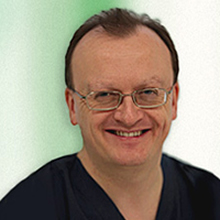Perspectives in cosmetic dentistry By Chris Orr
Cosmetic dentistry has changed a great deal over the years, and even more so over the last decade. Back when the British Academy of Cosmetic Dentistry (BACD) was founded back in 2003, cosmetic dentistry was very different to how it is today. The overall “look” we are trying to achieve nowadays – the aesthetic goals – have not really changed, but the means by which we achieve those goals have changed dramatically. The emphasis is now very much on trying to be as conservative of the natural tooth tissue as possible. This has largely been made possible by advances in forms of orthodontic treatment that patients will accept. In the past if patients had crooked teeth you would suggest they needed braces, but in many cases patients would not be willing to accept a course of treatment that could potentially take years. As such patients would ask for other options, and the only other option we’d have would be to cut away at their teeth.
Of course 10–12 years ago that kind of approach may have been acceptable, but now we have a whole range of short-term orthodontic appliances that have fast become a part and parcel of what we do. Developments such as Invisalign for example mean we can create a nice smile without having to be as destructive of a patient’s teeth as we might have been 10 years ago. This has gone hand-in-hand with a philosophical change in dentistry, so we are no longer saying, “look how well I’ve prepped this”; instead we are saying, “look how little I’ve prepped this”. Ultimately this change in how we approach dentistry is much better for the patient in the long run.
Another significant change we have seen in the industry has been the advancement in material technologies. Take veneers for example. We can now make veneers that are extremely thin, but still very aesthetic. Being so thing means less preparation is needed and some need no preparation at all. Filling materials have also improved dramatically. Recent research for example shows that composite restorations after 10 years are now just as successful as silver amalgam.
Given all these changes in dentistry I really don’t think there is such a thing as a “cosmetic” dental practice any more. Rather I think it is more accurate to say that cosmetic dentistry is just normal dentistry done well. This is because cosmetics, or aesthetics, are now a fundamental part of what we do on a day-to-day basis. Indeed many patients have come to expect their dentistry to be carried out in an aesthetically pleasing way, so we should be doing all we can to meet this demand. Ultimately this ties in very closely with what we are trying to achieve through our work at the BACD. We aim to share in our passion for excellence in dentistry, while providing the very best educational opportunities to our members that we can.
If you want to learn more about the changing nature of cosmetic dentistry, I will be presenting the opening lecture at the BACD’s 10th Annual Conference on Thursday 7th November, at the Hilton London Metropole Hotel. If you have not been before, I really do recommend you try and come along. We have an outstanding line up of speakers and I can guarantee you will come away with plenty of useful hints and tips that you can apply to your practice the very next day!
About the author:
Chris Orr is past President and Accredited Member of the BACD. He lectures widely and is the Course Director for Advanced Dental Seminars’ year course in Cosmetic and Aesthetic Restorative Dentistry.
Related Posts
Comments
By accepting you will be accessing a service provided by a third-party external to https://www.gdpuk.com/
